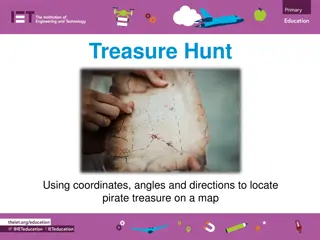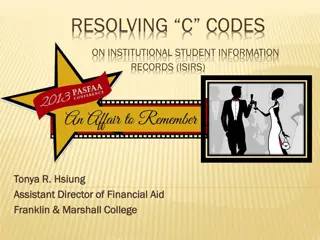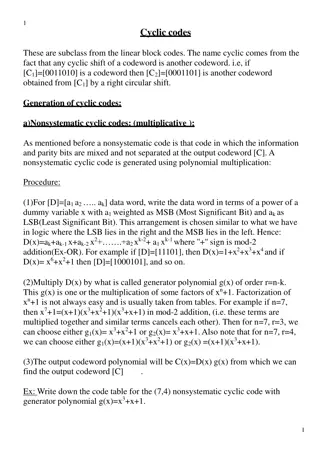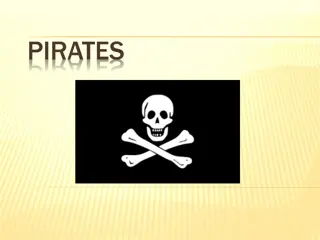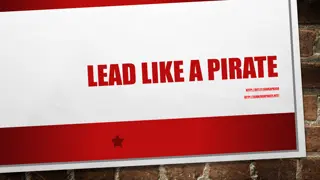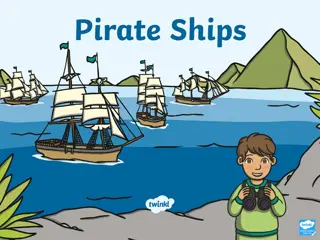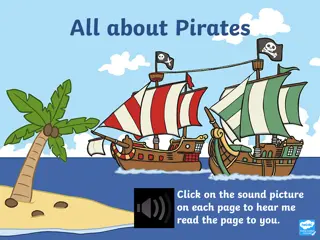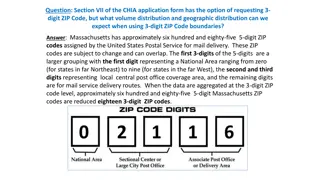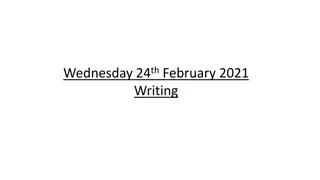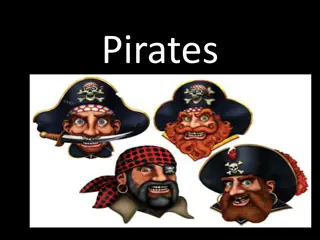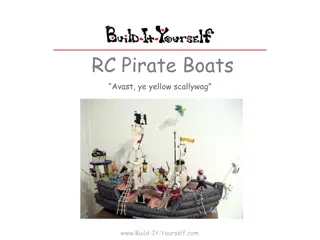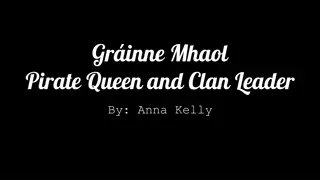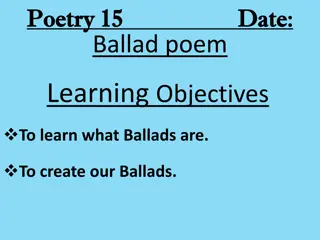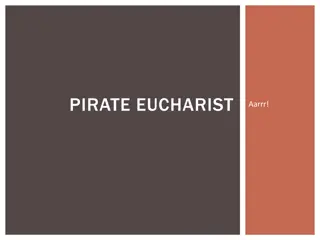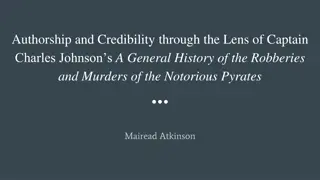Unraveling Pirate Life: Codes, Characters, and Notorious Pirates
Dive into the intriguing world of pirates through exploring their codes, infamous characters like Captain Edward Low, and the truth behind parrots and buried treasure. Uncover the democracy within pirate groups, stories of brutality, and historical documents shedding light on piracy in the Golden Age.
Download Presentation

Please find below an Image/Link to download the presentation.
The content on the website is provided AS IS for your information and personal use only. It may not be sold, licensed, or shared on other websites without obtaining consent from the author. Download presentation by click this link. If you encounter any issues during the download, it is possible that the publisher has removed the file from their server.
E N D
Presentation Transcript
STARTER Draw a pirate on your iPad or in the back of your book. Be ready to describe what a typical pirate does. Johnny-Depp-Pirates-of-the-Caribbean
Do Pirates have parrots and bury treasure? Today I will practice: 1. Source skills: using evidence to find information about the past 2. Research skills: finding information to answer an historical question. In this lesson, we will begin a short, two-lesson study on pirates. Do pirates fit the stereotypes drawn in your pictures? Pirates have been around since humans first built boats. Julius Caesar was twice captured by a group of Mediterranean pirates. He treated them with utter contempt and promised to crucify them when they let him go. They thought he was joking. Several days after his release, he returned and carried out his promise. During the Golden Age of Piracy, from the early 17th to the mid-18th century (c. 1600-1750), the boundary between lawful attack of enemy ships, in the name of defence (called privateering ) and piracy wasn't clear. http://www.ksspharmacy.nhs.uk/dyn/_pictures/_folder3/crossroads.jpg
Do Pirates have parrots and bury treasure? Finding out about pirates: Pirate Codes Pirate codes were documents that were organised by the entire pirate group, and were a form of democracy in a world that only knew monarchy (kings and queens). They offered health benefits for disabled pirates and laid down rules for how pirates should behave and be prepared for battle. Every pirate code was unique and was crafted by the pirates who sailed on the ship. Only a few survive: most pirates would destroy the code (or article ) the first chance they got, as they would be used against them at trial. What can pirate codes tell us about a piratical way of life?
Do Pirates have parrots and bury treasure? Edward Low Captain Edward Low was a notorious English pirate during the latter days of the Golden Age of Piracy (c. 1690-1724). He was born around 1690 into poverty in Westminster, London, and was a thief from an early age. He moved to Boston, in America, as a young man. In 1721, Low became a pirate, operating off the coasts of New England and in the Caribbean. He captained a number of ships, usually maintaining a small fleet of three or four. Low and his pirate crews captured at least a hundred ships during his short career, burning most of them. Although he was active for only three years, Low remains notorious as one of the most vicious pirates of the age, with a reputation for violently torturing his victims before killing them. The famous writer Sir Arthur Conan Doyle described Low as "savage and desperate.
Do Pirates have parrots and bury treasure? TASK: Read Edward Low s pirate code. Match each of the original pirate articles to the statement that explains what the article can tell us about piracy in 1600-1750 (the Golden Age of Piracy ). Write down your answers in a simple X-Z type format in the back of your book. One statement will match TWO articles. Answers: 1-D 2-F 3-G 4 & 7 E 5-A 6-B 8-C
EQ: Do Pirates have parrots and bury treasure? TASK: 1. Choose which settlement in the Caribbean you and your pirate crew want to raid . Find the relevant card in the booklet (e.g. if the house is in the square A2 then find that card and complete the activity). 2. To raid the settlement, you have to copy and complete three sentences. 3. There is buried treasure in one of the settlement squares (e.g. A1). Pirate crews who visited the square where the treasure is buried (and have copied and completed the sentences properly in that square!) will win some chocolate treasure. 4. So the more settlements you raid, the more chance you have of finding the buried treasure! There are eleven in total.
A B C D E F G 1 2 3 4 5
Plenary: Tell me three Types of pirates Types of pirate ships Examples of booty that pirates stole from merchant ships Pirates names Questions you would like answering on piracy. And the treasure is buried in square
A2: The beginnings of Piracy Pirates are sea robbers who prey on other ships and rob them of their goods and sometimes capture the ship itself for their own purposes. Piracy began over 2000 years ago in Ancient Greece, when sea robbers threatened the trading routes of Ancient Greece. Since then, this threat has continued amongst seafaring nations ever since, until the birth of regular navies. Roman ships were attacked by pirates who seized their cargoes of grain, and olive oil. The Vikings (which means sea-raider) were renowned for attacking shipping and coastal settlements. However, piracy really flourished between 1620 and 1720, and this period is known as the golden age of piracy. Between the sixteenth and nineteenth centuries, there have been different types of pirates, these being, privateers, buccaneers, and corsairs. Copy and Complete to raid this territory and have a chance of finding the treasure: Piracy began in Ancient ________, over __________ years ago. The word Viking means _____-_________ The golden age of piracy is between _______ and _________.
A3: Three types of pirates Privateers were lawful pirates who were authorised by their government to attack and pillage ships of enemy nations. They shared their profits with the government. Between the sixteenth and eighteenth centuries governments issued letters of marque which were licensed these sailors to plunder enemy ships. This was to prevent privateers from being charged with piracy, which was an offence punishable by death. Sir Francis Drake was England s most famous privateer. In the sixteenth century he attacked Spanish treasure ships returning from the new world, sharing his profits with Elizabeth I, who knighted him for his services. Buccaneers were pirates and privateers who operated from bases in the West Indies, and attacked Spanish shipping in the Caribbean. Corsairs were Muslim or Christian pirates who were active in the Mediterranean from the sixteenth to the nineteenth centuries. Copy and Complete to raid this territory and have a chance of finding the treasure: A Privateer is a lawful pirate supported by their __________. The most famous English privateer is Sir _______ _________ who shared his profits with Queen __________. Other types of pirates were called _______ and _________.
C1: Why become a pirate? Many pirates had served in merchant or naval ships before turning to piracy. Life on a pirate ship appeared more attractive as they were independent of national laws, the crew were treated much better than normal sailors and prize money was shared out equally. Most seamen became pirates as they hoped to become rich on plunders of treasure and cargo ships. When pirate ships captured merchant ships, the pirate captain would ask for volunteers to serve under him. Many of the crew would volunteer as life on a merchant ship was harsh and conditions awful. Becoming a pirate was called going on the account and they had to agree to live by the rules of the ship. These rules were often strict and breaking them could mean flogging or even death. If a pirate was found stealing from their comrades or deserting during battle, they were marooned on a desert island with meagre supplies. Most would die a slow death from starvation if they could not hunt or fish. Copy and Complete to raid this territory and have a chance of finding the treasure: Many pirates were previously seamen on ________ or __________ ships. Seamen often volunteered to become pirates to avoid _____________ and gain ______ Punishments for breaking ship rules included flogging, death, or being ______ on an _______
C2: Women Pirates There were not many women pirates, as seamen believed that it was unlucky to have women onboard ships. Women therefore had to disguise themselves as men. However there were some extremely powerful women pirates, such as Ching Shih who commanded a pirate community of 80,000. The two most famous women pirates were Anne Bonney and Mary Reed, who were captured in 1720 and put on trial in Jamaica. They were both sentenced to death, but escaped execution as they were both pregnant. Mary Reed died of fever a few months after the trial, but Anne Bonney was released. Copy and Complete to raid this territory and have a chance of finding the treasure: There were few women pirates because men thought they were ___________ The two most famous pirates were Anne Bonney and _______ ___________. They escaped execution because they were both __________!
C4: Pirate Flags & Pirate Plunder Pirates used flags to frighten passing ships into surrendering without a fight. The original pirate flags were blood red, and this signaled that no mercy would be shown once the pirates boarded and battle ensued. As piracy developed, more flags were used, and pirates often had their own flags. The Jolly Roger, (a skull and crossbone) is the most famous pirate flag. The symbol had been taken from the symbol used in ships logs, where it represented death on board. It was first used as pirate flag around 1700 and quickly became popular with pirates, who designed their own version of the flag, e.g. a skull and crossed swords. It was not only flags that were borrowed. Pirates often took over captured merchant ships and altered them to suit their purpose, such as to increase speed, cut more gunports, and also to hide the true identity of the ship. They also utilised weapons, clothes, medicines, and food found on board. Copy and Complete to raid this territory and have a chance of finding the treasure: The original pirate flags were ______ to signal no mercy! The most famous flag is the ______ _______ Pirates often took over merchant ships and added more _________.
D1: Pirate Ships Pirates required ships that were fast, powerful, and had a shallow depth below the water. This was because surprise was vital to a pirate attack, and they needed to be able to navigate in shallow coastal waters and hide in secluded coves and inlets. Schooners were used by pirates in North American waters. They were fast, easily manoeuvred, with a shallow draught but were large enough to carry many guns and a large crew. In the seventeenth and eighteenth centuries, the Barbary Corsairs used galleys, which were long and narrow with a sail. During action, these vessels were rowed to allow travel at speed. Each oar was manned by up to six slaves who were chained to benches. The aim of the corsairs was to ram the enemy ship, board and defeat the crew in hand- to-hand battle. The galleys were only suited to the Mediterranean where conditions were calm. Junks which were flat bottomed boats, with three masts and sails held together with bamboo rods, were used in Chinese waters. The largest junks held twelve guns and carried rowing boats to raid coastal villages or board enemy ships. Copy and Complete to raid this territory and have a chance of finding the treasure: Pirates needed ships with a _________ depth to hide in inlets and coves North American pirates used _________ and ________ used galleys, rowed by _______ The largest Junks, used in ________ waters, held twelve _______.
D3: Pirate Combat Pirates boarded ships by jamming the rudder with wooden wedges so that the ship could not be steered. They would then use grappling hooks to board the ship, heavily armed with pistols, daggers and cutlasses, which were suited to hand-to-hand fighting. Pirates also used homemade weapons, such as hand grenades made by filling wine bottles with gunpowder and created smoke screens by setting fire to yellow sulphur. Merchant seamen under attack tried to prevent pirates boarding by greasing decks or scattering dried peas or broken glass on the decks. However, they knew if they put up a strong resistance and lost, the pirates would show no mercy and they would be seriously maimed or murdered. The pirates would take all the treasure or cargo that the ship carried. These might include silks, jewels, spices, wine, brandy, linen, money or slaves. Sometimes the pirates added the captured ship to their fleet or sank it to get rid of any evidence that would convict them. The seamen would be killed, ransomed, taken as slaves or joined the pirate crew. Copy and Complete to raid this territory and have a chance of finding the treasure: Pirates boarded ships by jamming the _______ and then using _________ hooks Pirates favoured _______to_____ combat, using cutlasses and home-made ________ Seamen tried to prevent pirates boarding by ________decks or scattering broken ____
D4: Piracy Today & Piracy Remembered Although piracy has never returned to the level it was in previous centuries, it has not completely disappeared and the world s navies continue to try to prevent piracy. Attacks occur worldwide, mainly in developing countries. In the 1990s, political groups hijacked ships, threatening crews and passengers with death if their demands were not met. Pirates in South East Asia have attacked merchant shipping and in the Caribbean, ships have been attacked and robbed. Modern day pirates still rely on speed and surprise in their attacks. They use fast dinghies and arm themselves with assault rifles to overpower ships. Many ships today have smaller crews, relying on technology and so can be easily overpowered. During the nineteenth century storybook pirates were more famous than the real ones. Almost as soon as the world s navies had made the oceans safe, people quickly began to forget the reality of piracy. Many writers turned pirates into heroes. Byron (1788-1824) did much to create the myth of the romantic pirate hero in his poem The Corsair . Copy and Complete to raid this territory and have a chance of finding the treasure: In the _______, political groups hijacked ships Modern day pirates still rely on ______ and _________ The writer _________ created the myth of pirate as a _________ hero.
E4: Pirates and the Slave Trade Pirates became involved in the lucrative slave trade. The Barbary Corsairs found that by selling ship crew slaves or demanding a ransom for them was more profitable than the ship s cargo. During the seventeenth and eighteenth centuries, when the slave trade was big business, the profits from slavery attracted many pirates. Some became slavers, whilst others sold cargoes of slaves captured from the merchant ships bound for the American colonies, or from raids on the West African slave ports. Thus many pirates became a combination of slaver, privateer and pirate, and by the 1830s the term picaroon had come to mean both pirate and slaver. John Hawkins (1532-95) was the first English privateer to realise that the slave trade was a profitable trade. In 1562 he made the first of three voyages as a slaver, sailing from England to West Africa to load up 3000 slaves and took them to the Caribbean to be sold on the island of Hispaniola. Pirate captains in the Caribbean welcomed runaway slaves, who made up as much as one-third of some pirate crews. For slaves joining a pirate ship was more appealing than living the harsh life on the plantations as a slave. Copy and Complete to raid this territory and have a chance of finding the treasure: The term picaroon means both _______ and _________. The first English privateer to exploit the slave trade was _______ __________ Many slaves preferred life as a _________ than life on a plantation in America.
F3: Punishments for a Pirate The punishment for piracy was death by public hanging. The bodies of executed pirates were often tarred to preserve them to be hung from a gibbet. The corpse would be chained into an iron cage to prevent relatives from burying the body. The notable pirate, William Kidd, received this fate and his body hung for three years at Tilbury Point in the Thames estuary as a warning to seamen and pirates. A condemned man was measured for his iron cage before his execution, and many pirates feared this more than the hanging. After Blackbeard was killed in battle, his head was cut off and tied as a trophy to the yardarm of HMS Pearl. Copy and Complete to raid this territory and have a chance of finding the treasure: The punishment for piracy was _____ by ________ The body of the notable pirate _______ _______ was tarred and hung for ____ years A pirate would be measured for his _______ before execution.
G4: The End of Piracy Organised piracy and privateering was finally ended in the nineteenth century. In 1816, the bombardment of Algiers marked the end of the Barbary pirates power in the Mediterranean. Dutch warships patrolled Southeast Asia, and the British navy attacked pirates in the South China seas. However, at the beginning of the nineteenth century, lawful privateers were still flourishing until 1856 when the majority of maritime nations signed the Declaration of Paris. This banned letters of marque, and therefore outlawed privateering. Navies of each country were used to enforce this law. The age of steam also helped to end piracy as anti-slavery operations were now undertaken by steam ships. These could sail without wind and at great speed, while pirates still relied upon more cumbersome sailing ships. By 1850 there were only a small number of pirates remaining. Copy and Complete to raid this territory and have a chance of finding the treasure: The _________ of Paris ended Letters of _________, and so outlawed privateering _________ were used to enforce this new law. _________-Power helped end piracy


